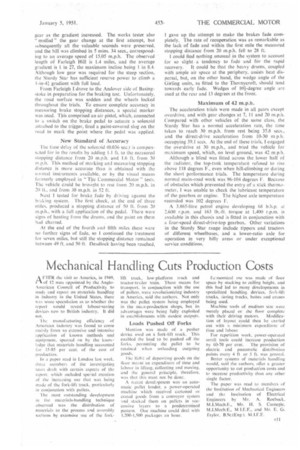Mechanical Handling Cuts Production Costs
Page 45

If you've noticed an error in this article please click here to report it so we can fix it.
AFTER the visit to America, in 1949, of 12 men appointed by the AngloAmerican Council of Productivity to study and report on materials handling in industry in the United States, there was some speculation as to whether the report would reveal labour-saving devices new to British industry. It did not.
'1 he manufacturing efficiency of American industry was found to come mainly from an extensive and intensive application of known methods and equipment, spurred on by the knowledge that materials handling accounted for 15-85 per cent. of the cost of production.
In a paper read in London last week. three member; of the investigating team dealt with certain aspects of the report, which included special mention of the increasing use that was being made of the fork-lift truck, particularly in conjunction with pallets.
The most outstanding development in the materials-handling technique observed was the distribution of materials to the process and assembly sections by extensive ase of the fork lift. truck, low-platform truck and tractor-trailer train. 'These means for transport, in conjunction with the use of pallets, were revolutionizing industry in America, said the authors, Not only was the pallet system being employed in the ma.;s-production shops, hut its advamagtes were being fully exploited in establishments with modest outputs.
Loads Pushed Off Forks Mention was made of a pusher device used on a fork-lift truck. This enabled the load to be pushed off the forks, permitting the pallet to he retained when unloading outgoing goods,
1 he habit of depositing goods on the floor meant an expenditure of time and labour in lifting, collecting and moving, and he general principle, therefore, was that this must not be done.
A recent develmment was an automatic pallet loader, a power-operated machine which received carioned or crated goods from a conveyor system and stacked them on pallets in successive layers to a predetermined pattern. One machine could deal with 1,200-1,500 packages an boor.
Fextornicat use was made of floor space by stacking to ceiling height, and this had led to many developments in specialized handling devices. fork-ilft trucks, .dering trucks, hoists and CralleS being used.
Machine tools of medium size were merely placed or the floor complete
with their driving motors. Modification of layout could then be carried out with a minimum expenditure of time and labour
For repetition work, power-operated small tools could increase production by 60-70 per cent. the provision of electric and pneumatic distribution points every 4 ft. or 5 ft. was general.
Better systems of materials handling would, said the authors; offer a greater opportunity to cut production costs and to increase productivity-than any other single factor.
The paper was read to members of the Institution of Mechanical Engineers and the Institution of Electrical Engineers by Mr. A. Roebuck, M.I.Mech.E., Mr. H. S. Carnegie, M.I.Mech.E., M.1.E.E., and Mr. E. G. laytor. B.Sc.fEng,k




















































































